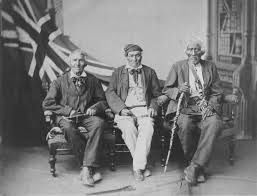The Iroquois' Great Law of Peace, or Constitution, specifically allowed for two types of leadership. Sachems were based on hereditary descent through the matrilineal line. However, men who distinguished themselves in battle or had other important skills or experience to offer could be appointed as Pine Trees, who had the authority to sit in council with the Sachems, advise them or work with them on important issues. We've already met one Pine Tree Chief, John Norton. John Smoke Johnson (1792-1886) was another veteran of the War of 1812 who likely would have worked with and known Norton quite well.
Though some sources erroneously indicate that John was related to Sir William Johnson, perhaps a grandson through Molly Brant or another Mohawk woman, he was not mixed race. John was born in 1792 on the Grant River Reserve in Canada. His father, Jacob Johnson, had been a godson of Sir William Johnson, who had sponsored him at his baptism into the Anglican faith. As was common custom at the time, Jacob Johnson took or was given an English first name and his sponsor's last name. Jacob Johnson married a woman of the Bear Clan, and passed the Johnson surname along to his children. John grew up just in time to serve in the War of 1812 along with another John, John Brant, who was also being groomed for a leadership role within the tribe. His service in the army as a Native auxiliary marked John Johnson as a warrior to watch.
On returning from the War, he married Helen Martin. Helen had been born to Dutch parents, so was of Dutch ancestry, but she had been captured as a child and reared among the Mohawk. She was considered a woman of the tribe, of the Wolf Clan, who could transmit status to her children. Helen and John had several children, one of whom, George Henry Martin Johnson, would become a Sachem of the Wolf Clan in time. In the years following the deaths of Brant, Norton and others of their generation, the tribe was in need of good leadership. John Johnson served as an interpreter, diplomat and buffer between his people and the British. The Great Council recognized his service by installing him as a Pine Tree Chief. Johnson posed with other veterans of the War of 1812 who became leaders among their people in an 1882 photograph. He died in 1886, in his nineties, respected by his people. His granddaughter Pauline Johnson, became a respected Native American poet. Sakayengwaraton is seated on the left, by the draped British flag below.


No comments:
Post a Comment